Das Wort des Jahres 2020 wird Corona sein, dass sich in wenigen Wochen so schnell verbreitete wie das Virus, das es bezeichnet. Um Corona herum sind viele Wortzusammensetzungen entstanden, ein eigenes Lexikon, von Corona-Abstrich, Kontaktverbot, Systemrelevanz, Ausgangsbeschränkungen, bis Öffnungsdiskussionsorgien. Die deutsche Sprache hat auf die Corona Krise kommunikativ effizient reagiert.
Wie hat die globale Gesellschaft auf Corona reagiert?
Was diese Pandemie getriggert hat, ist jetzt schon deutlich und sichtbar: Die Spaltung der Gesellschaft – eine Polarisierung nach Ideologie. Ideologie steht im weiteren Sinne bildungssprachlich für Weltanschauung. Im engeren Sinne wird damit zum einen auf Karl Marx zurückgehend das „falsche Bewusstsein“ einer Gesellschaft bezeichnet, zum anderen wird in der US-amerikanischen Wissenssoziologie jedes System von Normen als Ideologie bezeichnet, das Gruppen zur Rechtfertigung und Bewertung eigener und fremder Handlungen verwenden. Seit Marx und Engels bezieht sich der Ideologiebegriff auf „Ideen und Weltbilder, die sich nicht an Evidenz und guten Argumenten orientieren, sondern die darauf abzielen, Machtverhältnisse zu stabilisieren oder zu ändern“.
Ich beobachte mit Sorgen die gesellschaftliche Entwicklung. Ich habe mit vielen Menschen in meinem Umfeld darüber gesprochen. Die meisten bestätigen meinen Eindruck, dass die Missgunst, die verbale Aggressionen und vor allem die Bewertungskultur (auf ungefragter Basis) im Internet extrem zugenommen hat. „Kultur“ bezeichnet ebenso die Gestaltung des Zusammenlebens zwischen Menschen. „Kultur“ bezeichnet auch die Art und Weise wie wir privat und öffentlich miteinander umgehen. Dabei spielen politisch-kulturelle als auch sozial-ökonomische Einflussfaktoren eine große Rolle.
Die Fronten verhärten sich
Grünewald ist Leiter des Kölner Rheingold-Instituts, das mit tiefenpsychologischen Interviews die Stimmung in der Bevölkerung zu ergründen versucht. Seine neueste Studie ergab eine Zweiteilung der Gesellschaft: „Die eine Hälfte wünscht nichts sehnlicher als möglichst weitgehende Öffnungen, weil sie zuhause die Kinder beschulen muss oder um ihre wirtschaftliche Existenz fürchtet.“

Die andere Hälfte habe sich im Grunde ganz gut eingerichtet in der entschleunigten Zeit: „Da gibt es die Mutter, die die ganze Zeit bei ihrem Säugling ist. Die Eltern, die wieder ihre studierenden Kinder daheim haben. Das Liebespaar, das so viel Sex hat wie nie zuvor.“ Und die Mitarbeiter im Homeoffice, die keine finanziellen Einbußen wegen Corona hinnehmen müssen.
Diese beiden Lager stünden sich jetzt gegenüber.
Bedauernswert finde ich in diesem Zusammenhang, dass die Menschen scheinbar verlernt haben, sachlich zu diskutieren. Wenn man geteilter Meinung zu einer Sache ist, heißt das nicht, dass man die andere Person auf ihrer persönlichen Ebene kritisiert. Man ist lediglich anderer Meinung. Ich finde es sehr schade zu sehen, dass Familien in Streit geraten, wenn es um Sinn und Unsinn eines Mundschutzes geht. Freundschaften nehmen Schaden an viele Corona Fragen. Auf viele Fragen gibt es im Moment keine endgültigen Antworten. Das Thema ist hoch komplex und nur eine interdisziplinäre wissenschaftliche Zusammenarbeit wird sinnvolle Antworten finden. Es braucht Zeit!

Durch Herabsetzen stark fühlen
Die Ängste mit denen wir alle zu kämpfen haben, erklären aber nicht, die rasante Verbreitung von Beleidigungen in den sozialen Medien. Menschen die anders denken, werden als Idioten, Faschisten, Dummköpfe, Ignoranten, Spinner, Aluhutträger und vieles mehr beschimpft. Der Ton in den Medien wird rauer.
Ein Blog oder Bericht mit dessen Inhalten man nicht einverstanden ist, kann einfach ignoriert werden. Oder ich kann ein respektvoller Kommentar mit meiner Meinung abgeben. Was aber öfters passiert, ist das Menschen – Dinge die nicht gesagt wurden – rein interpretieren und gehen gleich danach in die Defensive. Einige gehen sogar weiter und beleidigen den Autor. Es geht um absichtliche Kränkungen. In diesem Fall will man die Menschen, die nicht zur eigenen Gruppe gehören, durch eine verbale Attacke ganz bewusst verletzen oder demütigen. Die Frage ist: Warum? Was wollen den Beleidiger genau bezwecken?
Die Gründe für dieses bewusste Abwerten von Mitmenschen können vielfältig und auch situationsbedingt sein.
Die beleidigende Person
- will vor anderen besser dastehen, sich überlegen fühlen,
- ist rhetorisch oder argumentativ nicht gewachsen und wehrt sich deshalb untergriffig,
- will provozieren, aus der Fassung bringen, um bloßzustellen.
Es gibt zahlreiche weitere mögliche Motive wie etwa Neid, Eifersucht, Unzufriedenheit mit sich selbst…
Sie sind aber immer auf das Persönlichkeitsbild des „Runtermachers“ zurückzuführen.
Gibt es eine Impfung gegen Angst?
Die Impfung gegen die Angst ist der respektvolle Dialog. Bleiben Sie im Gespräch, üben Sie vielfältiges Denken. Bleiben Sie cool und sachlich. Akzeptieren Sie, dass wir nicht auf alles eine Antwort haben können. Lernen Sie mit dieser Unsicherheit zu leben. Wenn es sachlich im Dialog nicht mehr weiter geht, lassen Sie es. Es führt zu nichts.
Die Gesellschaft erlebe nach der Flüchtlingskrise und der Klimadebatte nun die dritte Polarisierungs- und Radikalisierungswelle binnen weniger Jahre. Die Mehrheit der Gemäßigten sei deshalb gerade jetzt „gefordert wie selten zuvor“.
“Keiner/keine darf für sich den Besitz der Wahrheit beanspruchen, sonst wäre er/sie unfähig zum Kompromiss und überhaupt zum Zusammenleben; er/sie würde kein Mitbürger, sondern ein Tyrann. Wer das Mehrheitsprinzip auflösen und durch die Herrschaft der absoluten Wahrheit ersetzen will, der löst die freiheitliche Demokratie auf.”
Amtrittsrede von Richard von Weizäcker bei seiner Vereidigung im Deutschen Bundestag in Bonn, 1.07.1984
Wir müssen uns bewusst machen, dass die große Gefahr in dieser Pandemie das Nicht-Wissen ist. Unsicherheiten und fehlendes Wissen erzeugen Ängste. Jeder identifiziert sich mit seinen Ängsten und jeder wird von etwas anderem getriggert. Es geht auch viel um unsere Privilegien. Wir haben Angst vor Privilegienverlust.
Und nicht zu vergessen: Menschen machen andere schlecht, um sich selbst besser zu fühlen und/oder vor anderen (vermeintlich) besser dazustehen – oder vereinfacht gesagt: Sie machen andere klein, um sich groß zu fühlen.
Bei einem unfairen Angriff sollte man versuchen, ganz bei sich zu bleiben und nicht emotional zu reagieren. Man braucht sich nicht zu verteidigen, sondern nur sachlich zu bleiben. Es gibt Situationen, in denen Schlagfertigkeit nicht angebracht ist, vor allem wenn es um massive Beleidigungen und Androhung von Gewalt geht. Hier sei es sinnvoll, den Kontakt einfach abzubrechen.


